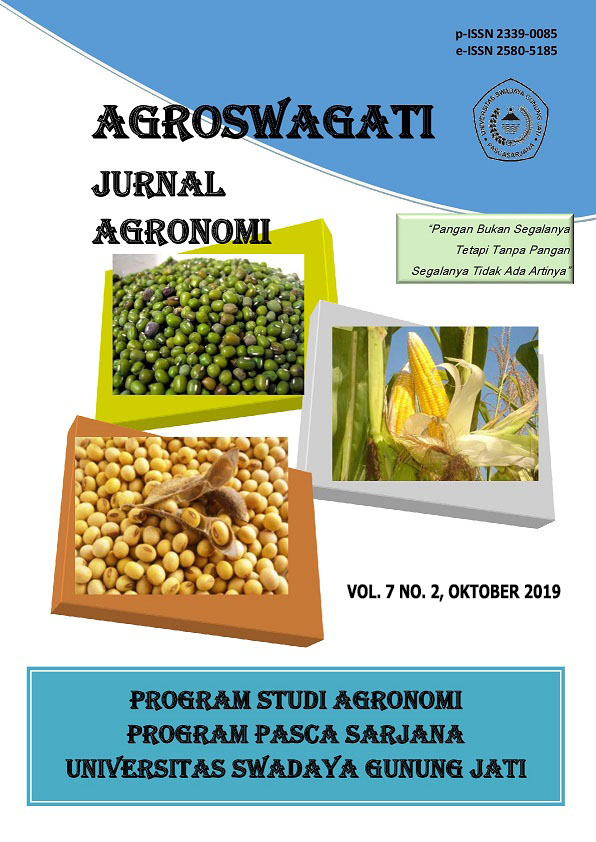RESPON PERTUMBUHAN TANAMAN DAN HASIL BEBERAPA VARIETAS PADI SAWAH TADAH HUJAN (Oryza sativa L.) AKIBAT PENERAPAN TEKNOLOGI
DOI:
https://doi.org/10.33603/agroswagati.v7i2.2800Kata Kunci:
Application of PTT technology, Conventional, and Rice Varieties.Abstrak
Rainfed land with an area of 1.4 million ha is the second rice barn after irrigation land for Indonesia. Understanding rainfed land is land that has a bund but cannot be irrigated with a certain height and time continuously. Therefore the irrigation of rainfed land is largely determined by rainfall so that the risk of drought often occurs in the area during the dry season. So far, rice varieties for rainfed land that have resistant properties to blast disease are still very limited. On the other hand, it is very necessary to diversify the resistant varieties of blast disease to overcome the disease so that the resistance genes are not easily broken. Therefore we need a number of varieties with a wide diversity of resistance genes that are recommended for planting by farmers. The Agricultural Research and Development Agency has released drought-tolerant rainfed lowland rice varieties and several pests and diseases such as Inpari 10, inpari 38, inpari 40, inpari 42, inpari 43 and HHZ5-DT1-DT1 lines. The research method used was Factorial RGD with the treatment of PTT application and conventional technology interacted with rice varieties.The results showed that the application of PTT technology had a real / good influence compared to conventional technology on the growth and yield of rice plants. PTT can increase production by 5.9% and income by 12.6%. Inpari 42, Inpari 43 and HHZ5-DT1-DT1 varieties are relatively more stable than other varieties and Inpari 43 has a higher production compared to other varieties.
Referensi
Badan Penelitian Pertanian. 2009. Pedoman Umum Pengelolaan Tanaman Terpadu Tanaman Padi Sawah. Badan Penelitian dan Pengembangan Pertanian. Kementrian. Jakarta.
Badan Pusat Statistik, 2016. Produksi, Luas Panen dan Produktivitas Padi di Indonesia pada Tahun 2012 – 2016.
Baihaki. 2004. “Jurnalâ€. Dinas Pertanian Provinsi Jawa Timur.
BPTP Sumatera Utara. 2010. Pengelolaan Tanaman Terpadu Padi Sawah. Sumatra Utara.
Departemen Pertanian. 2008. Pengelolaan Tanaman Terpadu pada Padi Gogo. Balai Besar Penelitian dan Pengembangan Pertanian, Subang. 28 Hal.
Evan Mungara, Didik Indradewa, dan Rohlan Rogomulyo, 2013
Evan Munggara, D. Indradewa dan R. Rogomulyo. 2013. Analisis Pertumbuhan dan Hasil Padi Sawah (Oryza sativa L.) Pada Sistem Petanian Konvensional, Transisi Organik dan Organik. Vegetalika 2 (no. 3) : 1 – 12.
Gomez, K.A dan A.A Gomez, 1995. Prosedur Statistik untuk Penelitian pertanian. (terjemahan). Universitas Indonesia.
Helmi. 2014. Peningkatan Produktivitas PadiI Lahan Rawa Lebak Melalui Penggunaan Varietas Unggul Padi Rawa. Balai Pengkajian Teknologi Pertanian Sumatera Utara Medan.
Jadid MN. 2007. Analisis sikap dan kepuasan petani padi terhadap benih padi (Oryza sativa) varietas unggul di Kota Solok, Sumatera Barat. Skripsi. Fakultas Ekonomi dan Manajemen. IPB. Bogor.
Kawano, N., Ito, O. & Sakagami, J. 2009. Morphological and physiological responses of rice seedlings to complete submergence (flash flooding). Annals of Botany. 103: 161-169. doi:10.1093/aob/mcn 171.
Masdar, 2006. Respon Pertumbuhan Reproduktif Tanaman Padi Terhadap Jarak Tanam dan Umur Bibit pada Sistem Intensifikasi Padi (SRI). Jurnal Akta Agrosia 9(2):130-135.
Matsushima, S. (1980) Rice cultivation for the million diagnosis of rice cultivation on techniques of yield inrease. Japan, Japan Scientific Press.
Murayama N. 1995. Fertilizer application to rice in relation to nutriphysiology of ripening. 2.j.Agri.Sci.24:71-77.(J) dalam skripsi H. Sukardi. 2006. Pengaruh Kombinasi Dosis Pupuk Anorganik (NPK) dan Organik Terhadap Pertumbuhan Dan Hasil Tanaman Padi (Oryza sativa L.). Fakultas Pertanian Unsika.
Patricia Claudya, Torey, Nio Song Ai, Parluhutan Siahaan, Susan M. Mambu .2013. Karakter morfologi akar sebagai indikator kekurangan air pada padi lokal Superwi. Universitas Sam Ratulangi Manado. Manado.
Rachman, B., I Wayan Rusastra & Ketut Kariyasa. 2000. Sistem Pemasaran Benih dan Pupuk & Pembiayaan Usaha Tani. Prosiding Analisis Kebijaksanaan. Pusat Penelitian dan Pengembangan Sosial Ekonomi Pertania. Bogor.
Schmidt, F.H and J.H.A. Ferguson. 1951. Rain Fall Types Based on Wet an Dry Period Rations for Indonesia with Western New Guinea. Jawatan Meteorologi dan Geofisika. Verhandelingen no. 42, Jakarta.
Sembiring, H. 2015. Kebijakan Penelitian dan Rangkuman Hasil Penelitian Tanaman Padi dalam Mendukung Peningkatan Produksi Beras Nasional. Prosiding Seminar Apresiasi Hasil Penelitia Padi Menunjang P2BN. Balitan Padi. Sukamandi. Subang.
Setijo Pujo. 2003. Budidaya Padi Tabela. Penebar Swadaya. Jakarta. Hal 59.
Simanulang, Z.A. (2001) Kriteria seleksi untuk sifat agronomis dan mutu. Pelatihan dan Koordinasi Program Pemuliaan Partisipatif dan Uji Multi Lokasi 9-14 April 2001. Balai Penelitian Tanaman Padi. Sukamandi.
Suparyono dan Setyono. 1993. Pengaruh Varietas, Populasi Tanaman dan Waktu Pemberian Pupuk N Terhadap Beberapa Penyakit dan Hasil Padi. Jurnal Penelitian Pertanian Tanaman Pangan, 20 (1) : 1 – 13. Dalam Pengaruh Dosis Pupuk Majemuk NPK terhadap Pertumbuhan dan Hasil Tiga Varietas Tanaman Padi (Oryza sativa L).
Suparyono, Sudir dan Suprihanto. 2001. Pathotype Profile of Xanthomonas campestris pv, oryzae, isolates from the rice ecosystem in Java Indonesian. Jurnal of Agriculture Science. Vol. 5(2) : 63-69.
Wahyuni, S. U. S. Nugraha dan Soejadi .2004. Karakteristik Dormansi Dan Metode Efektif Untuk Pematahan
Unduhan
Diterbitkan
Terbitan
Bagian
Lisensi
The Authors submitting a manuscript do so on the understanding that if accepted for publication, copyright of the article shall be assigned to Jurnal AGROSWAGATI, Sekolah Pascasarjana Ilmu Pertanian. Universitas Swadaya Gunung Jati as publisher of the journal. Copyright encompasses rights to reproduce and deliver the article in all form and media, including reprints, photographs, microfilms, and any other similar reproductions, as well as translations.
Jurnal AGROSWAGATI, Universitas Swadaya Gunung Jati and the Editors make every effort to ensure that no wrong or misleading data, opinions or statements be published in the journal. In any way, the contents of the articles and advertisements published in Jurnal AGROSWAGATIare the sole responsibility of their respective authors and advertisers.











